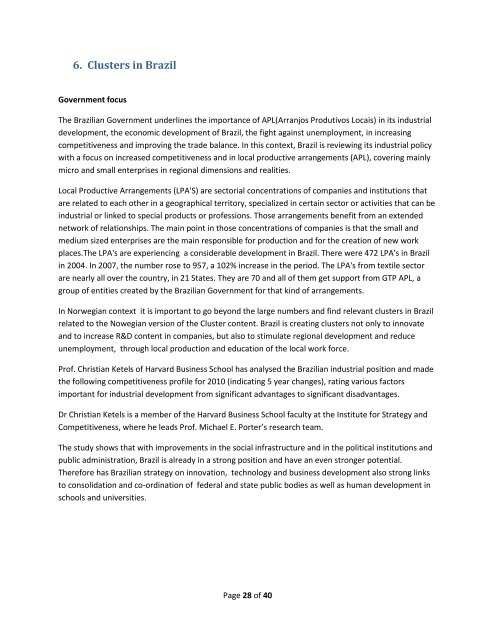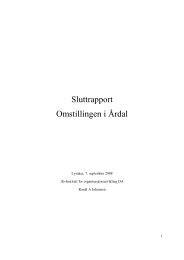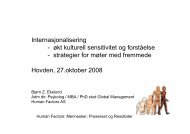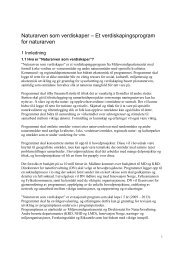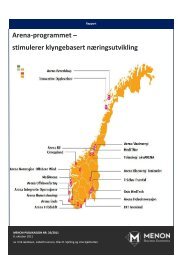Brazil, R&D and the role of clusters
Brazil, R&D and the role of clusters
Brazil, R&D and the role of clusters
You also want an ePaper? Increase the reach of your titles
YUMPU automatically turns print PDFs into web optimized ePapers that Google loves.
6. Clusters in <strong>Brazil</strong><br />
Government focus<br />
The <strong>Brazil</strong>ian Government underlines <strong>the</strong> importance <strong>of</strong> APL(Arranjos Produtivos Locais) in its industrial<br />
development, <strong>the</strong> economic development <strong>of</strong> <strong>Brazil</strong>, <strong>the</strong> fight against unemployment, in increasing<br />
competitiveness <strong>and</strong> improving <strong>the</strong> trade balance. In this context, <strong>Brazil</strong> is reviewing its industrial policy<br />
with a focus on increased competitiveness <strong>and</strong> in local productive arrangements (APL), covering mainly<br />
micro <strong>and</strong> small enterprises in regional dimensions <strong>and</strong> realities.<br />
Local Productive Arrangements (LPA'S) are sectorial concentrations <strong>of</strong> companies <strong>and</strong> institutions that<br />
are related to each o<strong>the</strong>r in a geographical territory, specialized in certain sector or activities that can be<br />
industrial or linked to special products or pr<strong>of</strong>essions. Those arrangements benefit from an extended<br />
network <strong>of</strong> relationships. The main point in those concentrations <strong>of</strong> companies is that <strong>the</strong> small <strong>and</strong><br />
medium sized enterprises are <strong>the</strong> main responsible for production <strong>and</strong> for <strong>the</strong> creation <strong>of</strong> new work<br />
places.The LPA's are experiencing a considerable development in <strong>Brazil</strong>. There were 472 LPA's in <strong>Brazil</strong><br />
in 2004. In 2007, <strong>the</strong> number rose to 957, a 102% increase in <strong>the</strong> period. The LPA's from textile sector<br />
are nearly all over <strong>the</strong> country, in 21 States. They are 70 <strong>and</strong> all <strong>of</strong> <strong>the</strong>m get support from GTP APL, a<br />
group <strong>of</strong> entities created by <strong>the</strong> <strong>Brazil</strong>ian Government for that kind <strong>of</strong> arrangements.<br />
In Norwegian context it is important to go beyond <strong>the</strong> large numbers <strong>and</strong> find relevant <strong>clusters</strong> in <strong>Brazil</strong><br />
related to <strong>the</strong> Nowegian version <strong>of</strong> <strong>the</strong> Cluster content. <strong>Brazil</strong> is creating <strong>clusters</strong> not only to innovate<br />
<strong>and</strong> to increase R&D content in companies, but also to stimulate regional development <strong>and</strong> reduce<br />
unemployment, through local production <strong>and</strong> education <strong>of</strong> <strong>the</strong> local work force.<br />
Pr<strong>of</strong>. Christian Ketels <strong>of</strong> Harvard Business School has analysed <strong>the</strong> <strong>Brazil</strong>ian industrial position <strong>and</strong> made<br />
<strong>the</strong> following competitiveness pr<strong>of</strong>ile for 2010 (indicating 5 year changes), rating various factors<br />
important for industrial development from significant advantages to significant disadvantages.<br />
Dr Christian Ketels is a member <strong>of</strong> <strong>the</strong> Harvard Business School faculty at <strong>the</strong> Institute for Strategy <strong>and</strong><br />
Competitiveness, where he leads Pr<strong>of</strong>. Michael E. Porter’s research team.<br />
The study shows that with improvements in <strong>the</strong> social infrastructure <strong>and</strong> in <strong>the</strong> political institutions <strong>and</strong><br />
public administration, <strong>Brazil</strong> is already in a strong position <strong>and</strong> have an even stronger potential.<br />
Therefore has <strong>Brazil</strong>ian strategy on innovation, technology <strong>and</strong> business development also strong links<br />
to consolidation <strong>and</strong> co-ordination <strong>of</strong> federal <strong>and</strong> state public bodies as well as human development in<br />
schools <strong>and</strong> universities.<br />
Page 28 <strong>of</strong> 40


